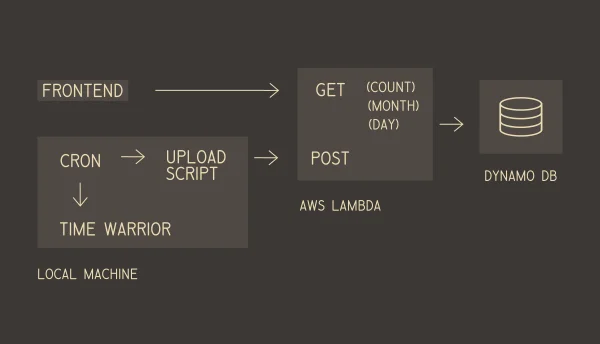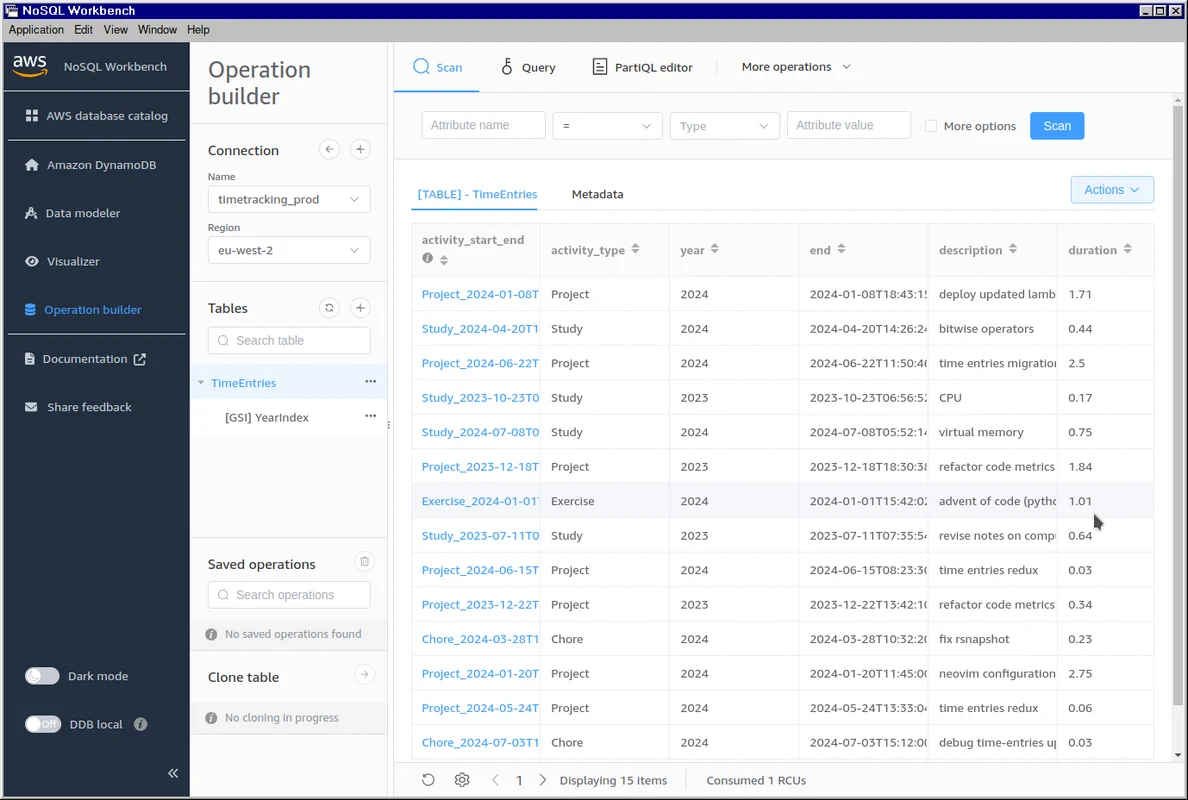7.3 KiB
| title | slug | date | tags | |||||
|---|---|---|---|---|---|---|---|---|
| Activity Log backend | /activity-log-backend/ | 2024-07-19 |
|
I have just added a new feature to the site: Activity Log, which presents my personal time tracking entries. This is how I configured the backend.
On my local machine I use TimeWarrior to record the time I spend on different activities. It runs from the terminal and can be exported to JSON.
To access the data remotely, I needed to store it in a database and be able to regularly export the time entries from my machine to the remote DB.
I created a simple AWS Lambda with a few endpoints:
- A POST that receives data and adds it to the database.
- A GET at
/countthat returns a count of the entries for each day for the last twelve months - A GET at
/monththat returns the entries for the last month - A GET at
/daythat returns the entries for the specified single date
The idea is that the frontend will first present all the entries for the current month in a table. Along with this there will be histogram similar to GitHub's commit graph that will present a colour coded representation of the amount of activity for each day in the last year. When the user clicks on a day, a request is made for the entries for that day. That way I don't have to load all the entries into memory at once.
In development, I used MySQL but it turns out that production SQL databases are prohibitively expensive on AWS. This figures as MySQL requires a permanently running server, contravening the serverless architecture that makes AWS otherwise affordable on the Free Tier.
After some research I decided to use DynamoDB. This didn't immediately occur to me because, in my ignorance, I assumed a key-value database only permits one key to one value and my table contains multiple fields for each row. In fact, after specifying a unique primary key, you can associate it with any number of values (known as "attributes"), thus creating a "table-like" data structure.
The nomenclature for DynamoDB is quite confusing but I was able to create a simple table-like structure with the following schema:
{
"TableName": "TimeEntries",
"AttributeDefinitions": [
{ "AttributeName": "activity_start_end", "AttributeType": "S" },
{ "AttributeName": "year", "AttributeType": "S" }
],
"KeySchema": [{ "AttributeName": "activity_start_end", "KeyType": "HASH" }],
"GlobalSecondaryIndexes": [
{
"IndexName": "YearIndex",
"KeySchema": [
{ "AttributeName": "year", "KeyType": "HASH" },
{ "AttributeName": "start", "KeyType": "RANGE" }
]
}
],
"ProvisionedThroughput": {
"ReadCapacityUnits": 1,
"WriteCapacityUnits": 1
}
}
The attribute activity_start_end is my primary key which is basically
equivalent to the primary key in SQL: the value I use to uniquely individuate
each entry in the table. It is a simple concatenation of the fields
activity_type, start, end. The latter two are ISO timestamps, ensuring
uniqueness.
A global secondary index (GSI) is an attribute in addition to the primary key
that you may use to group entries. By suppling a GSI with your query you can
reduce the compute required for lookups. By using year as a GSI I ensure that
the query will only run against values matching the specified year.
When working locally, I used Docker to create a DynamoDB image. As the AWS SAM
software (used for running the Lambda and API Gateway locally) also uses a
Docker container (that you can't inspect or modify) it was necessary to specify
a bridging network in the docker-compose.yml so that each container could
communicate:
services:
dev:
image: amazon/dynamodb-local
container_name: timetracking_dynamodb_dev
ports:
- "8000:8000"
volumes:
- "/home/thomas/repos/lambdas/node-js/time-tracking/data/dev:/home/dynamodblocal/data/dev"
command:
"-jar DynamoDBLocal.jar -dbPath /home/dynamodblocal/data/dev --sharedDb"
networks:
- sam-local
networks:
sam-local:
driver: bridge
With the server running I could then view the database using Amazon's NoSQL Workbench client:
Creating the Lambda with TypeScript was simple enough using the AWS SDK. Here is the function that I use to return the entries for the month and specific dates:
import { DynamoDBClient } from "@aws-sdk/client-dynamodb"
import { DynamoDBDocumentClient, QueryCommand } from "@aws-sdk/lib-dynamodb"
import { generateDates, TPeriod } from "./generateDates"
interface ITimeEntry {
activity_start_end: string
year: string
start: string
end: string
activity_type: string
duration: number
description: string
}
const getTimeEntries = async (
client: DynamoDBClient,
timePeriod: TPeriod
): Promise<ITimeEntry[]> => {
const documentClient = DynamoDBDocumentClient.from(client)
const dateParams = generateDates()[timePeriod]
const params = {
TableName: "TimeEntries",
IndexName: "YearIndex",
KeyConditionExpression:
"#yr = :year AND #start BETWEEN :start_date AND :end_date",
ExpressionAttributeNames: {
"#yr": "year",
"#start": "start",
},
ExpressionAttributeValues: {
":year": dateParams.year,
":start_date": dateParams.start,
":end_date": dateParams.end,
},
}
const command = new QueryCommand(params)
const response = await documentClient.send(command)
return (response?.Items as ITimeEntry[]) || []
}
export { getTimeEntries, ITimeEntry }
(The DynamoDBDocumentClient proved essential. It ensures that each row comes
back as an array of objects matching the shape of ITimeEntry. Without this,
the data returns in a nested format specific to DynamoDB that is cumbersome to
work with.)
Outside of the Lambda and setting up the database, it was necessary to write some scripts to glue the different parts together:
- a Python script that exports the entries from TimeWarrior, parsing them into the format the database expects
- a Python script (running on a cron timer) that runs the preceding export script every hour and uploads to the remote DB using the Lambda's POST endpoint, sending a notification to my Slack channel
- a Bash script to migrate the contents of the production database to my local Docker instance (useful when working on the frontend locally)
- a Bash script to seed the production and local databases from a CSV
That's basically it. The biggest pain point was getting my DynamoDB Docker instance to communicate with the default SAM instance. That, and converting my SQL version into DynamoDB. I wouldn't say I find DynamoDB particularly straightforward or fun to use but I'll put up with it because it costs like £00.02 per month compared to the £54.00 they were asking for MySQL.

